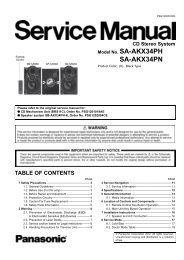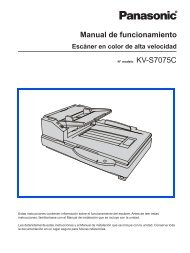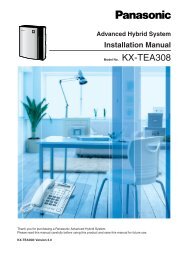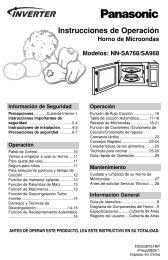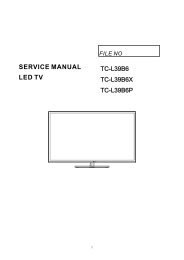You also want an ePaper? Increase the reach of your titles
YUMPU automatically turns print PDFs into web optimized ePapers that Google loves.
<strong>KX</strong>-<strong>TDA100BX</strong><br />
9.1.4. Circuit Description<br />
9.1.4.1. Outline of Block Description<br />
· CPU block<br />
Operates the main unit control. Also operates various controls, generation of select signal, DMA control and serial port control.<br />
This contains the built-in clock function.<br />
· ASIC block<br />
Provides the communication between each optional service card, call control (TSW function), conference call, tone generation<br />
and gain control function.<br />
· Memory block<br />
This is a work area used for the main unit control program storage, the system boot program storage, or the user configuration<br />
data storage.<br />
· USB block<br />
Provides the USB I/F function. Connects to the PC to be used for PC programming or system data load/store.<br />
· SD card block<br />
Provides the SD card I/F function and loads the main unit program and the system data from the SD card containing the main<br />
unit control program.<br />
· MOH/PAGING block<br />
Provides the external music on hold input x 2, and the external paging output x 2 port. Also this provides the external music on<br />
hold input 1 system and exclusively the internal music on hold output.<br />
· Power block<br />
Consists of DC/DC converter circuit and various regulators.<br />
9.1.4.2. Detail of Block Description<br />
· CPU block<br />
Configuration: IC101 (CPU), IC107 (reset IC), IC103 (spread clock IC), X101 (CPU source clock), X102 (clocking clock) etc.<br />
Function: (IC101)<br />
Generates the select signal in accordance with the memory map and operates read/write of data between each peripheral.<br />
Controls the DMA transfer between USB I/F or built-in serial controller and memory.<br />
Operates input/output control of each I/O signal in accordance with the program.<br />
Contains the built-in clock function (battery backup) with the source clock X102 (32.768 kHz).<br />
(IC107)<br />
Monitoring the power voltage, it generates a reset signal when the voltage drops under the constant value (2.9Vtyp) or when<br />
the reset switch is pressed down.<br />
(IC103)<br />
To reduce unnecessary radiation, it generates the clock with the constant blurring mainly X101 clock output (16.384 MHz).<br />
Description of the Signal on MPR<br />
Signal Name<br />
Functions<br />
+15VIN +15V DC<br />
+15V For Circuit +15V DC MOH<br />
+9.4V For Driver IC +9.4V DC RS-232C<br />
+5V For Driver IC +5V DC RS-232C<br />
+5VRMT Reserve<br />
3.3V_BB +3.3V DC<br />
For pull-up of back board signal line<br />
+3.3VB +3.3V DC<br />
Battery backup<br />
For SRAM (IC301, IC302) backup<br />
+3.3V +3.3V DC<br />
1.9VB +1.9V DC<br />
Battery backup<br />
For clock function of CPU (IC100)<br />
1.8V For Core +1.8V DC CPU (IC100)<br />
A[0]-A[25] Address bus<br />
nAC_ALM AC alarm signal: Indicates AC voltage cutoff. (L: Alarm condition)<br />
nBACK Bus Acknowledge: Indicates Bus Acknowledge.<br />
nBATT Indicates whether external battery is connected or not. L: Connected<br />
26



